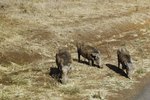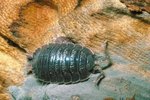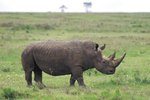
The giant panda (Ailuropoda melanoleuca) is an iconic figure all over the world, with his black eye patches and furry, massive paws. It's not easy to picture a giant panda without his dietary staple -- bamboo. These woody grasses are by far the bulk of what a giant panda consumes within the span of a day.
About Giant Pandas
Free-roaming giant pandas live exclusively in the southern central region of China. These sizable omnivores have endangered status, according to 2008's International Union for Conservation of Nature Red List of Threatened Species report. Habitat destruction and limitation due to logging and agricultural activities are both big risks to giant pandas, population wise. As far as natural habitat goes, giant pandas generally live in montane forest environments. They do particularly well in especially wet settings.
Pounds of Bamboo
The diet of giant pandas is all about bamboo, bamboo and more bamboo. These solitary mammals generally eat somewhere between 20 and 40 pounds of it each day, according to the Smithsonian National Zoological Park. Bamboo isn't very high in nutrients, and because of that, giant pandas have to eat it in very copious amounts. They're only able to receive roughly 17 percent of the nourishment from the stalks and foliage of bamboo. For a giant panda, a minimum of half the day revolves around bamboo consumption and searching. If a panda is really famished, he can even eat upwards of 84 pounds of bamboo in just 24 hours, indicates the San Diego Zoo.
Bamboo Nutrition
Although giant pandas occasionally eat other things, bamboo reigns supreme in their diets. Approximately 99 percent of what giant pandas eat is bamboo, according to Animal Diversity Web of the University of Michigan. One of the reasons they eat it so faithfully is dependability. Bamboo is easy for giant pandas to acquire no matter what time of the year it is.
Other Components of the Giant Panda Diet
Apart from bamboo, giant pandas also occasionally eat bugs, fruit, bulbs and other grasses. Once in a while, giant pandas even feed on the decaying remains of other animals, known as carrion. They also eat tiny rodents, musk deer fawns, birds and fish.
References
Photo Credits
-
Jupiterimages/Photos.com/Getty Images




